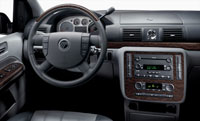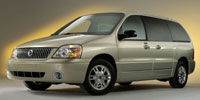 The Mercury Monterey is essentially a Ford Freestar with a higher level of equipment and some Mercury styling cues. The Monterey offers luxury touches such as a dual climate control system, wood-and-leather steering wheel with built-in cruise and audio controls, and power adjustable pedals.
The Mercury Monterey is essentially a Ford Freestar with a higher level of equipment and some Mercury styling cues. The Monterey offers luxury touches such as a dual climate control system, wood-and-leather steering wheel with built-in cruise and audio controls, and power adjustable pedals.Safety is its strong suit, with both active handling safeguards and comprehensive passive passenger protection. Its third-row seat folds flat into the floor, offering lots of cargo space for a family of four, and it can carry up to seven.
On the road, the Monterey is smooth and quiet with responsive steering and handling. Parking is made easier by its front and rear park-assist system. The Monterey comes with a big 4.2-liter V6 that packs a lot of torque, giving it good performance. It's rated to pull trailers of up to 3,500 pounds when equipped with the optional Class II towing package.
The Monterey stands out with its three-row Safety Canopy airbag system designed to offer head protection for passengers in all three rows, an occupant-sensing front-passenger airbag, and four-wheel anti-lock disc brakes. The optional AdvanceTrac stability control with traction control and panic Brake Assist can help the driver maintain control. Also available are a tire-pressure monitoring system and self-sealing tires. With a reinforced structure to absorb offset frontal impacts, Monterey earned the highest possible score (five stars) in government frontal crash tests. The Monterey comes recommended by the insurance industry for its offset-frontal crash performance.
Lineup
The 2006 Mercury Monterey comes in only one trim level, the well-equipped Luxury edition, previously the designation for the mid-level version of the Monterey. The manufacturer's suggested retail price for the 2006 Monterey Luxury ($28,930) is reduced from the 2005 price.
It comes with front-wheel drive, the 4.2-liter V6 engine, a four-speed automatic transmission, and anti-lock brakes (ABS).
Interior equipment includes first- and second-row captain's chair seats, and a cloth-trimmed third-row seat that folds flat into the floor or tilts back to form a convenient tail-gate spectator seat. Cloth upholstery is standard. Also standard: dual-zone air conditioning, tilt leather and wood-trimmed steering wheel with cruise and audio controls, a six-way adjustable driver's seat with lumbar adjustment, power-adjustable pedals with memory, power sliding doors, third-row reading lamps and roof rails. Securilock anti-theft system, overhead and front floor consoles with storage, and a park assist system that works going forward as well as in reverse are also standard.
Safety features that come standard include an occupant-sensing front passenger air bag, Safety Canopy curtain and side-impact air bags, perimeter anti-theft system, and heated power-adjustable side mirrors with built-in turn/warning signals. AdvanceTrac electronic stability control with Brake Assist and Traction Control ($730) is optional. Self-sealing tires ($195) are also available.
Options include leather seats ($890), heated and cooled front seats with suede-insert leather seating surface ($1485), a DVD rear-seat entertainment system ($1,385), and a power liftgate ($400). Also available: a class II towing package ($335), rear spolier ($290), and 17-inch bright machined nine-spoke aluminum wheels ($245).
Walkaround
The Mercury Monterey is a traditionally styled minivan that blends in with the scenery. Most of its bodywork is shared with the Ford Freestar. The vertically textured waterfall grille and more restrained headlamps distinguish the Mercury and suggest a family resemblance to the bolder Mountaineer sport-utility.
Satin-aluminum accents and a monochromatic color scheme hint at the Monterey's upscale ambitions. The optional liftgate spoiler adds a sporty note.
One unusual design feature is the way the front side windows lower below the inside portion of the door trim. When the window is fully down, the inner door panel sticks up above at a comfortable armrest height.
Turn-signal repeaters in the outside mirrors are a nice feature, helping to warn other motorists of your intentions, which can be particularly helpful when someone is in your blind spot. An interesting safety feature we noticed was that whenever one of the sliding side doors is open the mirror signal on that side blinks. It's a clever idea, and could help alert passing motorists that people are getting in or out of your Monterey.
The standard keypad entry-access system is another nice Ford touch, making it possible to get into the locked vehicle without the keys, if you know the combination. This is particularly nice, for example, on camping and skiing trips, when a family member without the keys may need access to the vehicle. Many Ford owners have grown accustomed to this feature.
Interior

The Mercury Monterey features the same interior as the Ford Freestar, but with more upscale materials. The focal point of the interior is a watch-like clock in the middle of the center dash. Both wood and bright-metal accents add richness.
Heating and air conditioning controls offer three zones of control (driver, front passenger, and rear) to tailor the temperature for your individual passengers. The rear A/C works well and can be a critical feature for kids and pets on hot days. The audio controls work fine, but don't exude quality. No navigation system is available.
Given Monterey's luxury aspirations, its seats could be more comfortable. The front seats are like bar stools, with narrow bottoms that lack side support. However, they do offer the option of cooling and heating, a nice feature on hot summer afternoons and cold winter mornings.
The Monterey seats seven: two in front, two in the second row, three in the third row. Like the front seats, the second-row captain's chairs are narrow and lack support, but there's plenty of room for two adults. The third-row bench seat works for pipsqueaks, but its short seat height makes it cramped for teenagers. Getting to the third row is relatively easy. The second-row seatbacks can be folded with one hand, which makes life easier when loading stuff in back. And the seat bottoms can be tumbled forward for crawling into the third row.
The Monterey offers plenty of room for cargo. Even when all seats are in place for seven passengers, there's 31.5 cubic feet of cargo space behind the third row. A well behind the third row helps corral grocery bags or loose odds and ends.
The third row folds easily into that well, leaving a large, flat floor and 71.6 cubic feet of cargo space. The seat's operation is among the best. Simply pull a set of clearly labeled straps numbered in sequence and the third row disappears. The head restraints push down into the seat so they don't have to be removed, a nice feature. The third-row bench can be dropped backwards to make a comfortable rear-facing bench, with the lift-gate as a canopy, handy for tailgate parties.
The second-row seats don't disappear into the floor, but do flip up to create more cargo room. They fold and tumble forward like those on the Mountaineer, for easy access to the third row or to create even more cargo room. The second-row seats can be removed, but it's clumsy and a task better suited for two people. Doing so does turn the Monterey into a major cargo hauler, however, with 131 cubic feet of cargo space.
The Monterey has lots of storage for odds and ends, from bins in the rear sliding doors for books and toys to double map pockets in the front doors. A covered storage compartment on top of the dash is a good spot for cell phones and other small items. The storage compartment at the bottom of the center dash and in the center console are handy for all kinds of things, but the plastic lids feel cheap. Cup holders abound, including front door holders for 20-ounce bottles. A sturdy, convenient cup holder folds down from the side of each of the second-row seats. If kicked, as they likely will be, they snap back into their storage position against the seats. The cup holders in the third row are awkwardly positioned.
Driving Impressions

The Mercury Monterey is powered by a 4.2-liter overhead-valve V6, the largest offered in this class. It delivers 265 pound-feet of torque, more than the Nissan Quest and the Toyota Sienna. This advantage is important since torque is the force you use when pulling away from intersections, climbing a steep grade, or towing a trailer. The Mercury V6's 201 horsepower doesn't measure up to the 240 horsepower of the Nissan nor the 230 horsepower of the Toyota, but this is often less important. The four-speed automatic transmission shifts smoothly and quickly and makes good use of the engine's power.
We found the Monterey to be smooth and quiet, though it's not the most refined minivan in terms of noise and vibration. Steering and handling is responsive. The brakes are effective and smooth and easy to modulate for nice, smooth stops in daily driving.
Parking is made easier with the Monterey's excellent park-assist system, which signals the driver with increasingly fast beeping tones as the bumper approaches another object. The front and rear use different tones, making parallel parking a breeze. We found that the system beeped when someone walked in front or behind us, which can be helpful in crowded parking lots.
Summary & Specifications
The Mercury Monterey is an extremely competent minivan. It shares much in common with the Ford Freestar, which generally carries a lower list price than does the Monterey. However, depending on the trim level and content package, a Monterey with all of its standard fare could represent a better value than a Freestar that has to be loaded up with options. And Mercury offers features that the Freestar does not, including a seat-cooling system and perforated suede upholstery in the first and second rows. [source : automotive.com]
Post a Comment